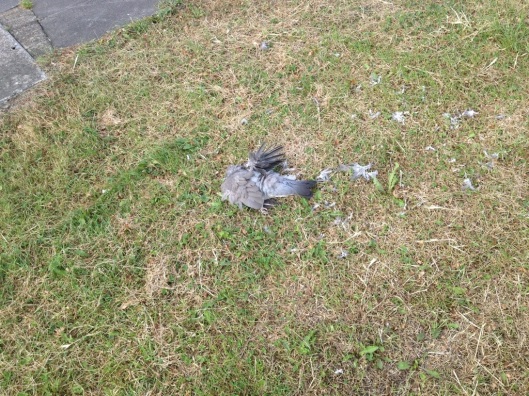Tags
Archosaurs, art, bird, carcass, decomposition, Dinosaur, maggots, Oviraptor, Protoceratops, study
Sometimes you can search for blog post inspiration for weeks… and then the ideal subject just falls right in your lap. In this case, I’m glad that wasn’t literal.
On Monday morning I was walking to work and saw a dead pigeon on the grass near the roadside. That in itself is nothing unusual in London – even after the prohibition on feeding pigeons in Trafalgar Square and installation of the ‘anti-pigeon spikes’. The face was a little damaged and the neck contorted at an uncomfortable angle but, other than that, this Columba specimen seemed more or less intact. Had it flown into the wing mirror of a moving motorcycle, perhaps? Maybe it was attacked by a predator that was then spooked? I didn’t get close enough to determine. All I knew for certain was that it hadn’t been there last night when I went out for milk & hobnobs. I didn’t think much more of it.
Tuesday came and my dead pigeon was still there. He had a few flies now but he was, more or less, unchanged.
On Wednesday morning, an unusual transformation started to occur: his feathers, once sitting flat against his body, started to fan out! It continued to do this slowly & steadily until this (Friday) morning – see photos below. I assume the reason for this gradual splaying of the feathers is due to maggot activity within the carcass, or chemical reactions as the internal organs decompose and the membranes between them collapse – introducing things to one-another that would not normally meet. I’m sure one of you will have a clearer idea of what’s going on here.
Why am I telling you all this? Because, if you’re anything like me, you will one day want to draw a juvenile Protoceratops inquisitively nudging a days-old Oviraptor carcass and unless, like the emu, they spread their fore-limbs in a futile gesture Oviraptor was almost certainly fully feathered. This means we can learn much about how they rot from their long distant cousin: the dead pigeon. I almost hope Hendon/Finchley/Colindale council don’t notice he’s there for a few more days – I’m most curious to see what happens to him next. If there’s more to his story, I’ll update this post.
Saturday sees the specimen collapse in upon itself. He now resembles a macabre nightdress case (see ‘day 6’ photo below)
Sunday: looks like the scavengers finally took notice. All that remains are primary feathers & straggling down fluff.
Images




Pingback: Ada Lovelace Day « Palaeosam's Blog